#blended learning
Text

guaranteed masterpiece is about to hit big screen 🍿
took me about a week to finish this. really makes me want this movie to happen by a looking at it
1K notes
·
View notes
Text

Зачаток коровы 🐄
#русский tumblr#личный блог#русский тамблер#личный пост#русский блог#турумбочка#русский пост#блог о жизни#самообразование#моделирование#3d model#blended learning
20 notes
·
View notes
Photo

Blended learning is an educational approach that combines traditional face-to-face instruction with the elements of online learning techniques. It allows students to engage with educational material in a more flexible way, both in a classroom and through online platforms.
(via The future of blended learning (infographic))
22 notes
·
View notes
Text
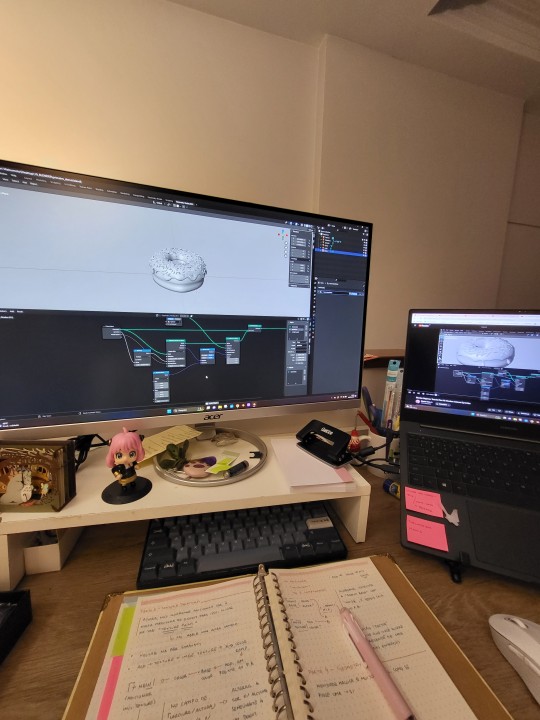
11.05.23
Hoje o dia foi cheio de pequenas coisas, mas ainda assim pareceu bem devagar.




A primeira parte do dia consistiu em ir na Liberdade:
BORI CAFÉ: pequena portinha no caos do lado de lá da liberdade. Ambiente pequeno mas muito aconchegante, apenas com o essencial (o essencial mais charmoso e fofo ♡). O café em si é simplesmente delicioso, um gostinho de café que estava com saudade. A comidinha ficou por conta do cookie perfeito do OOEY COOKIE, sabor doce de leite com nozes. Realmente não tem como errar nesse combo
FONOMAG: acabei não tirando fotos, mas fomos conhecer essa livraria que vimos ha algum tempo no Instagram. Tinha muitca coisa bacana, mas infelizmente era muito caro. :(((
MOMO LAMEN: Fazia tempo que não comia o lamen deles, e noooosssaaa estava uma delícia!!! Que saudade de um bom chashyu braseado/maçaricadooo. O meu pedido foi um Shio Chasyu Lamen e estava 10/10.




A segunda parte do dia se resume a essas 4 imagens: CONSEGUI FAZER O DONUT NO BLENDER!!!
Sinceramente, me sinto invencível. Não tem mais aqua barreira inicial. Agora quero fazer mais tutoriais!! Uhuul !
🎧: já ouviram Ayano Kaneko? Esse álbum aqui é muito legal!! 🐰🌸🐥🌻🍀
13 notes
·
View notes
Text



2 notes
·
View notes
Text

#education technology#higher education#online education#educate yourselves#education#learning disability#blended learning#online learning#distance learning#exam preparation#exam study#examination#ai technology#technology#artificial intelligence
2 notes
·
View notes
Text
Unveiling the Pedagogical Panorama: Deciphering Blended Learning
In the ever-evolving landscape of education, the paradigm of instruction continually undergoes metamorphosis. Amidst this transformative tide, Blended Learning emerges as a beacon, illuminating the path toward a harmonious amalgamation of traditional methodologies and modern technological advancements. As we delve into the intricate tapestry of educational methodologies, it becomes imperative to comprehend the essence of Blended Learning, a term oft-discussed but sometimes misunderstood.

At its core, Blended Learning epitomizes a pedagogical approach that integrates the conventional classroom setting with digital platforms, fostering an enriched educational experience that transcends the constraints of time and space. It encapsulates a diversified ecosystem wherein face-to-face interaction coalesces with online resources, creating a symbiotic synergy that enhances the learning journey. Blended Learning encapsulates versatility, offering learners the flexibility to engage with educational content through a multifaceted prism.
Blended Learning permeates various educational domains, from K-12 education to higher academia and corporate training. Statistics reveal a burgeoning adoption rate, with a report by Ambient Insight projecting the global Blended Learning market to reach a staggering $18.4 billion by 2027, indicative of its burgeoning significance in the educational landscape.
This innovative pedagogical paradigm bears testament to the adage that "Variety is the spice of life," as it affords educators the liberty to curate a diverse array of instructional strategies tailored to meet the unique needs of learners. By seamlessly interweaving traditional classroom discourse with digital resources such as multimedia presentations, interactive simulations, and online forums, Blended Learning cultivates an immersive learning environment that nurtures critical thinking skills and fosters collaborative learning experiences.
A quintessential facet of Blended Learning lies in its emphasis on personalized learning pathways, wherein learners assume an active role in charting their educational voyage. Through the judicious integration of Learning Management Systems (LMS) and adaptive learning technologies, educators can tailor content delivery to cater to individual learning preferences and aptitudes, thereby nurturing a culture of self-directed learning and autonomy.
Dr. Bernard Bull, Assistant Vice President of Academics at Concordia University Wisconsin, eloquently encapsulates the essence of Blended Learning, stating, "Blended learning is not about replacing teachers with technology; it's about amplifying what teachers can do." This profound insight underscores the symbiotic relationship between pedagogy and technology, wherein educators harness digital tools as catalysts to augment the efficacy of their instructional practices, rather than supplanting the indispensable role of human mentorship.
Furthermore, Blended Learning transcends the confines of geographical boundaries, heralding a new era of globalized education wherein learners can partake in collaborative endeavors and cultural exchanges irrespective of their physical location. Virtual classrooms and online collaboration platforms serve as conduits for cross-cultural dialogue and knowledge dissemination, fostering a spirit of interconnectedness and cultural appreciation.
As we traverse the Blended Learning terrain, it is imperative to acknowledge the inherent challenges and impediments that accompany this pedagogical paradigm. Issues pertaining to digital equity, access to technology, and digital literacy underscore the imperative for equitable educational opportunities. Thus, initiatives aimed at bridging the digital divide and ensuring universal access to technological resources are quintessential for realizing the full potential of Blended Learning as a catalyst for educational equity and social empowerment.
In conclusion, Blended Learning epitomizes a transformative educational ethos that transcends the confines of traditional pedagogy, heralding a new era of innovation and inclusivity in education. By fostering a dynamic synergy between conventional classroom instruction and digital resources, Blended Learning empowers learners to embark on a personalized educational odyssey imbued with versatility, collaboration, and self-directed inquiry. As we navigate the educational landscape of tomorrow, let us embrace the ethos of Blended Learning as a harbinger of pedagogical evolution and societal progress.
References:
Ambient Insight. (2021). "The 2021-2026 Worldwide Blended Learning Market."
Bernard Bull. (n.d.). In BrainyQuote.com
0 notes
Text
Exploring Blended Learning: Enhancing Education Through Technology Integration
0 notes
Text
Transform Learning with Pentonix's Blended Solutions!
We're combining the best of in-person and online experiences for dynamic, engaging education.
Learn more about our Blended Learning Solutions :

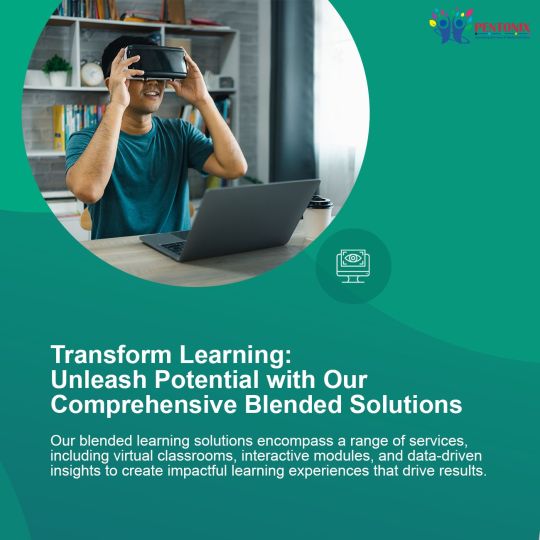
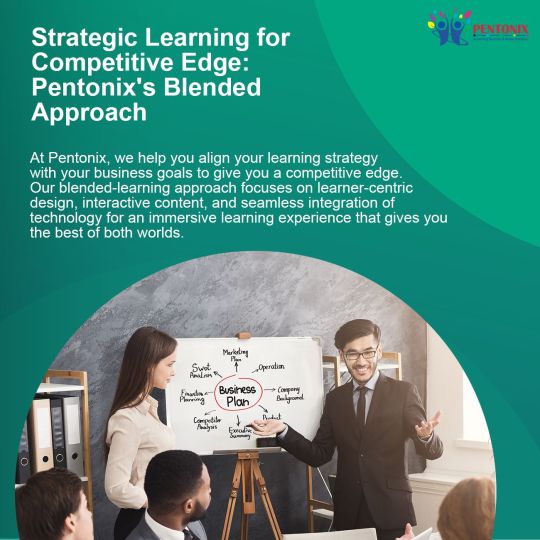
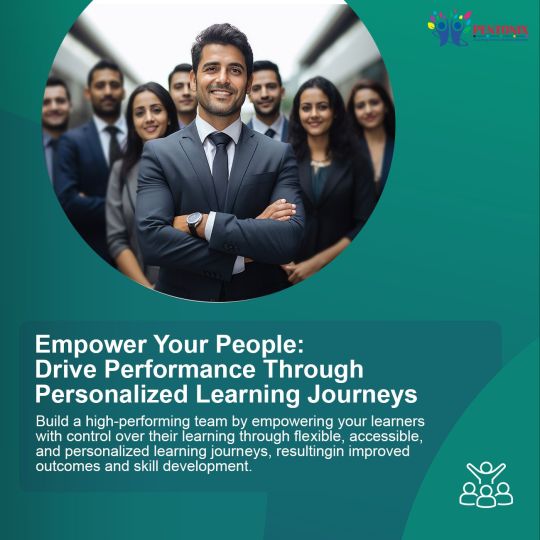

1 note
·
View note
Text
Using Instructional Design to Improve Learning Environments
Photo by Kenny Eliason
Using Instructional design to improve learning environments is a concept slowly becoming a requirement in education and industry. Although instructional design only recently becoming a phrase more widely used it has been a subject of discussion and study for many years.
Visionaries?
In 1964, Gene Roddenberry created Star Trek based on a society that had forgone currency…

View On WordPress
#Assessment and Evaluation#Blended Learning#Content Development#Curriculum Design#E-Learning#EdTech Trends#Educational Resources#Educational Technology#Gamification in Education#Instructional Design#Instructional Design Models#Instructional Strategies#Interactive Learning#Learning Management Systems (LMS)#Microlearning#Mobile Learning#Online Learning#Professional Development for Educators#Training and Development#User Experience (UX) in Learning
1 note
·
View note
Text
Unleashing the Power of Blended Learning: Best Practices and Benefits
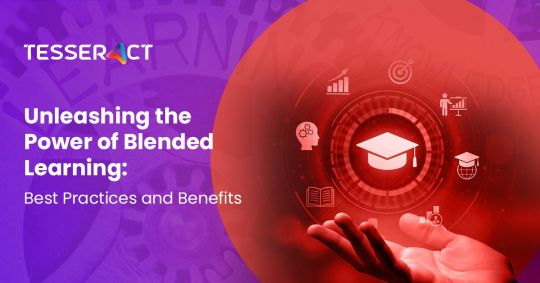
Introduction Summary
In the rapidly evolving world of learning and development (L&D), traditional classroom teaching methods are no longer the only option. Blended learning has emerged as a powerful and effective approach to learning, combining the best of both in-person and online learning methods. This approach aims to harness the benefits of both traditional and digital learning, offering a more comprehensive and flexible learning experience to the learners.
Introduction
In the realm of learning and professional development, one size does not fit all. Learners come with diverse backgrounds, learning styles, and preferences. Traditional teaching methods, while effective for some, often fall short when it comes to engaging and accommodating this diversity. This is where blended learning comes in. Blended learning is a dynamic learning approach that offers the best of both in-person teaching and online learning. In this blog, we'll explore some best practices and the benefits of this innovative learning approach.
What is Blended Learning?
Blended learning is a versatile learning model that combines face-to-face classroom instruction with online learning components. It combines the advantages of traditional classroom instruction with the flexibility and interactivity of online learning. In a typical blended learning environment, learners participate in both in-person sessions and engage in online activities and resources.
Benefits of Blended Learning
Here are some important benefits of blended learning.
Flexibility and convenience: One of the important benefits of blended learning is the flexibility it offers to both learners and instructors. With a good mix of in-person sessions and online components, learners can create a schedule that best suits their needs. In-person sessions allow for direct interaction with instructors and peers, fostering social and collaborative skills. They can access course materials online, allowing them to learn at their own pace. This flexibility is particularly advantageous for employees with work schedules, as it allows them to continue learning without compromising on other responsibilities.
Enhanced engagement: Blended learning combines the advantages of traditional classroom interaction with interactive and multimedia-rich online learning materials. This approach can be more engaging for learners, as it caters to various learning styles. In-person sessions provide opportunities for face-to-face interaction with instructors and peers, while online components offer interactive multimedia, quizzes, and simulations, making the learning experience more dynamic and engaging.
Personalized learning: Blended learning empowers learners to take control of their learning journey. Online components often feature adaptive learning tools and resources that can personalize the learning experience based on individual progress and preferences. This personalization ensures that learners can focus on areas where they need improvement, thereby maximizing their learning outcomes.
Access to a wide range of resources: The components of blended learning programs offer learners access to a vast array of resources. From e-books and articles to videos and interactive simulations, learners can explore various formats of learning content that cater to different learning preferences. This diverse range of resources enriches the learning experience and provides opportunities for deeper understanding and exploration.
Improved learning outcomes: Studies indicate that blended learning can lead to improved learning outcomes. This approach allows instructors to cater to the diverse needs of their learners and adapt their teaching or training methods accordingly. It also provides a platform for regular assessments and feedback, helping learners to better grasp the course material and perform well in their job roles.
Cost effective: Blended learning programs can be a cost-effective solution for both employees and organizations. By utilizing online resources and reducing the need for physical infrastructure, organizations can cut down on operational expenses. Moreover, learners can save on commuting and accommodation costs associated with traditional, full-time training programs.
Better time management: Blended learning programs encourage learners to develop strong time management skills. With a mix of in-person sessions and online components, learners must plan their schedules effectively to balance their responsibilities. This skill is highly valuable in the modern workforce, where time management is a key asset.
Best Practices for Successful Blended Learning Programs
Here are some best practices to unleash the power of blended learning.
Set clear learning objectives: The foundation of any successful blended learning program is well-defined learning objectives. Before designing your blended learning program, clearly outline what you want your learners to achieve. These objectives should be specific and achievable. Also, ensure that both in-person sessions and online components of your course align with these objectives.
Choose the right blend: Blended learning allows for a wide range of approaches and combinations. Select the right mix of online and in-person activities. Each component should complement the other. For example, use in-person sessions for discussions, hands-on activities, and collaborative projects, while online resources can be utilized for self-paced learning and assessments.
Make effective use of technology: Ensure that both you and your learners are comfortable with the technology used in your blended learning environment. Ensure that they have access to the necessary resources, such as technical support, learning materials, and tools. Provide training and support as needed.
Create engaging online content: The effectiveness of online content is vital to the success of blended learning programs. Therefore, it is essential to create engaging and interactive online content. This can include videos, quizzes, discussion forums, interactive content, and multimedia resources. Make sure the content is well-organized, easy to navigate, and accessible to all learners.
Promote engagement and interaction among learners: Use online discussion boards, forums, and video conferencing to encourage peer-to-peer collaboration and discussions. This can help foster a sense of community among learners. Encourage discussions, group projects, and peer feedback to foster a sense of community and shared learning experiences.
Implement a balanced system for feedback: Use both formative and summative assessments to monitor progress and provide timely feedback. Online quizzes, assignments, and in-person presentations can be used to
assess the learners.
Recognize the diversity of your learners and their learning styles: Offer flexible learning options and ensure that online materials are accessible to all, including those with disabilities. The online materials include digital resources like video lectures and interactive modules. These enable self-paced learning and accommodate a variety of learning styles.
Maintain open and regular communication with learners: Use email, announcements, and online hours to provide guidance and address concerns. Learners should feel supported throughout the course or training program.
Focus on continuous improvement: Gather feedback from learners and reflect on your teaching and training methods. Use the feedback to continuously improve the course and adapt your approach as needed.
Make use of blended learning models: There are different models of blended learning. Each model has some strengths and few weaknesses. The popular models include the flipped classroom, rotational, and flex models. In the flipped classroom model, learners learn by watching pre-recorded videos/lectures at home and then complete the assignments or activities in the classroom. This enables for more individualized learning, as instructors spend more time with each learner. In the rotational model, learners learn by rotating through different activities, games, assignments, or places throughout the day, which include online or offline activities and face-to-face instruction. This allows for a good blend of individualized learning and group work. In the flex model, learners have control over the pace and place of their learning. They learn from online resources or in the classroom and read through the material in their own time.
Conclusion
Blended learning is more than just a buzzword in the world of learning and professional development. It represents a powerful approach to learning that leverages the advantages of both traditional instruction and online learning. By allowing learners to engage with content in multiple ways, offering flexibility and customization, and embracing technology, blended learning is shaping the future of learning. Its potential to cater to diverse learning styles, improve engagement, and make learning accessible to a broader audience makes it a game-changer in the modern learning landscape. As the world of learning continues to evolve, blended learning is likely to play an even more prominent role in shaping the future of learning and training.
At Tesseract Learning, we discuss your challenges and work with your team in understanding your business needs, learner expectations, and technology environments. If you wish to know how our services, KREDO learning platform, and Prodient.io authoring tool can help your organization create effective blended learning programs for your employees, contact us and write to us at [email protected].
0 notes
Text
Anticipated Effects of AI on Learning in 2024
Are there any benefits of personalised learning facilitated by AI? Read the article and give your feedback
Lucubrate Magazine January 7th 2024
This article analyses current trends and possibilities of AI in education and its anticipated effects on learning by 2024. The paper explores how we can integrate AI into education, the potential challenges and opportunities, and the expected impact on teaching methods and learning outcomes. The article aims to provide insight into the role of AI in…

View On WordPress
#2024#Adaptive Learning#Administrative tasks#AI#AI Language Model#AI technologies#AI technology#Arteficial intelligence#Behavioural learning#Blended Learning#Classroom#Classrooms#Deep learning#Development#Digital#Digital Learning#Education#Education 4.0#Education for All#Education for Sustainable Development#Flipped classroom#Future#Generation#Individual learning#new technologies#Next generation#One-size-fits-all#Pedagogy#Pedagogy of sketching#Personalised learning
0 notes
Text
Blended learning
The Evolution and Benefits of Blended Learning in Education
In the rapidly evolving landscape of education, the traditional methods of teaching and learning are undergoing a significant transformation. One of the key innovations that has gained prominence in recent years is "blended learning." This approach combines traditional face-to-face instruction with online learning components, creating a hybrid model that offers a unique and effective educational experience.

Definition of Blended Learning:
Blended learning, often referred to as hybrid learning, is an instructional strategy that integrates traditional classroom teaching with online learning activities. This approach seeks to leverage the strengths of both in-person and digital learning, providing a more flexible and personalized learning experience.
Key Components of Blended Learning:
In-Person Instruction:
Traditional classroom sessions with teachers and students interacting face-to-face.
Opportunities for real-time discussions, group activities, and hands-on learning experiences.
Online Learning:
Virtual classrooms and digital platforms that facilitate self-paced learning.
Access to multimedia resources, interactive simulations, and collaborative online tools.

Benefits of Blended Learning:
Flexibility and Accessibility:
Blended learning allows students to access course materials and participate in activities at their own pace and convenience.
Learners can review content as needed, catering to various learning styles and preferences.
Personalized Learning:
The combination of in-person and online elements enables educators to tailor instruction to individual student needs.
Adaptive technologies and analytics help track student progress and provide targeted interventions.
Enhanced Engagement:
The incorporation of multimedia elements and interactive online tools makes learning more engaging and dynamic.
Students can collaborate with peers both in person and virtually, fostering a sense of community.
Cost-Effectiveness:
Blended learning can potentially reduce costs associated with traditional classroom setups.
Online resources and digital materials often eliminate the need for extensive printed materials and other physical resources.
Preparation for the Digital Age:
By integrating online components, students gain valuable digital literacy skills.
Exposure to online collaboration tools and virtual communication prepares students for the demands of the modern workforce.
Challenges and Considerations:
Technological Barriers:
Unequal access to technology may create disparities in learning opportunities.
Schools need to ensure that students have access to the necessary devices and a reliable internet connection.
Teacher Training:
Educators may require training to effectively integrate technology into their teaching methods.
Ongoing professional development is crucial to keeping pace with evolving digital tools and strategies.
Conclusion:
Blended learning represents a dynamic shift in the educational paradigm, combining the best of traditional teaching methods with the advantages of digital technologies. As schools and educators continue to adapt to the changing needs of students, the implementation of blended learning offers a promising approach to fostering a more flexible, engaging, and personalized learning environment. By addressing challenges and embracing the potential of this innovative model, education can better prepare students for success in the 21st century.
0 notes
Text
School Integrated Program
Sarvanga Education: Unlocking the Future of Learning with School Integrated Program
Well, talking about the School Integrated Program, let us tell you that at Sarvanga Education, we are offering the best programs for all the 12th-grade students who are looking ahead to prepare for the NEET or JEE entrance examinations.
The School Integrated Program (SIP) at Sarvanga Education offers a perfect blended learning approach that holds the combination of face-to-face instruction with the flexibility and interactive nature of online learning. This unique and student-friendly model allows students to benefit from personal attention shared by expert teachers along with modern technology.
With this School integrated program, Sarvanga Education aims to offer a comprehensive JEE and NEET preparation, ranging from foundation levels (Grade 9) to the advanced levels (Grade 12), through a flexible and versatile model encompassing offline, hybrid, and online mode of learning and teaching.
There is no denying the fact that school is indeed an integral part when it comes to the holistic development of a student and reinforcing confidence and positive competitive spirit in students is notably important in such crucial situations when the world is all about ambitious mindsets, perseverance, resilience, and hope.
The school-integrated program is undoubtedly a good deal breaker for students as it offers endless benefits when it comes to the development of a student in building a bright future in the world of education. These kinds of programs help students plan their future careers or professions which leads his/her to be independent thinkers. Sarvanga Education offers a completely customized educational program that provides the dual object of ‘Excellence in School/Board Exams + Cracking competitive exams like IIT, JEE/NEET, etc.
At Sarvanga Education students are offered affordable and high-quality blended learning classes for CBSE or ICSE curriculum schools, as well as for students who are preparing for NEET or JEE entrance examinations. Sarvanga Education aims to empower students from all across the country, especially from small cities and towns with the best and most experienced teachers well-versed with the latest technology to succeed academically and achieve the ultimate goals of their life.
Sarvanga Education aims to tutor its students for all the major competitive examinations so that all its students are prepared to give their best and also deliver optimum performance even if the pattern of the exam is changed at the last minute. At Sarvanga Education we always focus on imparting quality education to all our students, while also equipping them to appear for various All-India competitive examinations.
Not only students but schools and institutions also experience great advantages with Sarvanga Education’s School integrated program. Let's discuss them in brief-
Pioneering Institution
Sarvanga Education has a proven track record of providing quality education at an affordable cost, catering to diverse schools and peer groups. Not only limited to collaborating with pioneer schools and institutions we also specialize in crafting tailor-made programs that align specifically with the unique needs of each school.
Flexible Program Scheduling
Our school-integrated education programs can be organized to suit the convenience of your school's timetable while offering bilingual and regional language support to facilitate better understanding and inclusivity among students. With our school-integrated program, we aim to offer a 360° approach, covering academic support, branding, and admission support to ensure a holistic educational experience.
Tailored Programs
Sarvanga Education specializes in crafting tailor-made programs that align specifically with the unique needs of each school Our classes commence as per the school's convenient schedule. Sarvanga Education provides services as per school needs.
Flexible Study Material Formats
Sarvanga Education caters to diverse learning preferences by providing study materials in both online and offline modes (as per the class format), ensuring students can access resources according to their chosen learning methodology.
Well, these were some of the benefits that schools get to witness with Sarvanga Education’s School Integrated Program. Now let’s see what the advantages that Sarvanga Education’s School Integrated Program offers to all its students-
Affordability and Convenience
By offering classes within students' own schools, we aim to eliminate the need for extra travel or additional expenses that students have to bear during their travel. Our pocket-friendly services are accessible to a wide range of students and their families with the objective of the best results.
All-Inclusive Support
Our school-integrated program offers comprehensive support to all the students through practical exercises, assessments, and a tailored curriculum to meet the specific requirements of CBSE and ICSE boards, while taking care of the board, we also aim to provide all-inclusive support to our students in every possible aspect.
Psychological Assessment and Career Counseling
In addition to academic services, Sarvanga Education also offers personalized psychological assessments to all its students to get thorough with student’s strengths, weaknesses, and interests. Based on the result, our counselors offer career counseling sessions to students guide them, and also help them in choosing the right career path.
Empowering Holistic Development
At Sarvanga Education we completely understand the importance of mental well-being in academic performance and overall success. Therefore our objective is to empower our students to make informed decisions about their future and enhance their confidence and self-esteem so that they can perform well in their chosen field.
Well apart from the above-mentioned benefits, there are some other advantages that Sarvanga Education’s School Integrated Program has to offer to all its students also takes great pride in this program. Let’s discuss them below-
Integrated Education for a Digital Era
Sarvanga Education fully understands the importance of staying ahead in the digital age not only to succeed but also to win the race, and that is why the "School Integrated Program" is designed in such a way that it will cater to the needs of modern learners in every possible way. This innovative and advanced education approach perfectly combines various educational elements such as "Blended Curriculum," "Interdisciplinary Education," "Cross-Disciplinary Education," and "Multi-Domain Learning."
Understanding and Embracing to a Changing World
In response to the challenges posed by the COVID-19 pandemic, Sarvanga Education seamlessly transitioned to "Hybrid Classes" and "Digital Board School" solutions to offer the safest and most easily accessible learning to all its students. These online options ensure that learning never stops, even in the face of adversity.
The Sarvanga Difference
It’s not only school, Sarvanga Education is more than that. It is an educational ecosystem that fosters innovation, critical thinking, and adaptability keeping its students in it’s mind. With the "Integrated Study Approach," all the students are encouraged to explore multiple domains, collaborate across disciplines, and develop a deeper understanding of the world around them.
In conclusion, Sarvanga Education's "School Integrated Program" is nothing but a visionary approach to education, where we are preparing our students for the real-life challenges and opportunities of the 21st century. By embracing integrated learning, interdisciplinary education, and digital solutions, Sarvanga Education is paving the way for a brighter future for all its students.
FAQ’s about Sarvanga Education ‘School Integrated Program’
What is Sarvanga Education's teaching methodology?
With years of experience in the field of education, when it comes to learning in the 21st century we at Sarvanga Education believe in a holistic approach that focuses not only on syllabus and academic excellence but one that helps students develop CHARACTER, CREATIVITY, VALUES, and A SPIRIT OF LEADERSHIP. We foster innovation, critical thinking, and adaptability keeping our students in it’s mind. With the "Integrated Study Approach," all the students are encouraged to explore multiple domains, collaborate across disciplines, and develop a deeper understanding of the world around them.
What does Sarvanga Education offer?
We provide coaching for classes VI to XII for CBSE & ICSE students along with our School Integrated Program we offer tutoring for All-India major entrance examinations like JEE, NEET, and others.
Does Sarvanga Education offer Integrated coaching for competitive exams?
Yes, Integrated coaching is offered with the Board of Intermediate syllabus, and students will be prepared to face a variety of competitive exams for both Commerce and Sciences.
How does Sarvanga Education assist students in choosing integrated programs?
With the help of our trained student counselors and their detailed counseling, students will be guided and counseled to assess their interests and skills and decide upon a career that is best suited for them.
Do you offer coaching for IIT?
At Sarvanga Education and its school-integrated program, students will be mentored for JEE advanced based on their ability, it is not a generic approach followed for all students. We strongly believe in preparing students based on their ability and strength will help them get admission into the top 25% of Engineering colleges.
Contact SARVANGA EDUCATION
Make your child's education a priority with SARVANGA EDUCATION. Contact us today to learn more about our services and how we can help your child achieve academic excellence.

#School integrated program#blended learning#integrated learning approach#stem education#innovative teaching methods#experiential learning#progressive education
0 notes
Text
Tapatoru's Fresh Take on Professional Learning: Shaping the Future of Education
Ready to dive into how this programme is revolutionising professional learning for tertiary educators in Aotearoa New Zealand? Let's go!
Ready to dive into how this programme is revolutionising professional learning for tertiary educators in Aotearoa New Zealand? Let’s go!
Tapatoru – A Fresh Approach to Teaching
Picture this: a programme that’s not just about learning stuff, but also about weaving Māori and Pacific values right into the heart of education. We’re talking literacy, numeracy and neurodiversity, all rolled into…
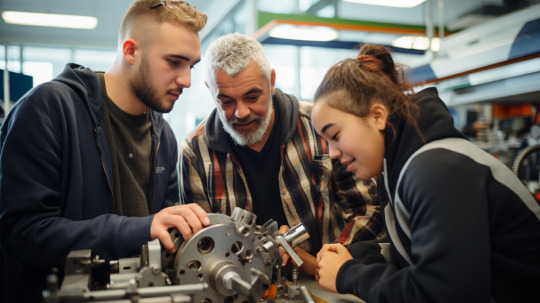
View On WordPress
#adaptive learning#Adult Learning#Ako Aotearoa#blended learning#Cultural Inclusivity#cultural integration in education#cultural respect in teaching#educational strategies#educational transformation#future of education in Aotearoa#innovative teaching methods#interactive learning#Maori traditions in education#Māori and Pacific values#New Zealand tertiary education#professional learning development#Reciprocal Learning#Reflective Practice#Tapatoru Programme#teaching excellence
0 notes
Text
Exploring Blended Learning: Enhancing Education Through Technology Integration
In the ever-evolving landscape of education, one approach that has gained significant traction in recent years is blended learning. Blending traditional classroom instruction with online learning tools and resources, blended learning offers a dynamic and flexible approach to teaching and learning that caters to the diverse needs and learning styles of students. At Radhai Inksap School, we recognize the potential of blended learning to enhance the educational experience and prepare students for success in the digital age.
What is Blended Learning?
Blended learning, also known as hybrid learning, combines face-to-face instruction with online learning components. This approach allows students to engage with course materials, collaborate with peers, and receive personalized feedback both in the classroom and through digital platforms. Blended learning offers the best of both worlds, harnessing the power of technology to enrich learning experiences while maintaining the benefits of in-person interaction and teacher guidance.
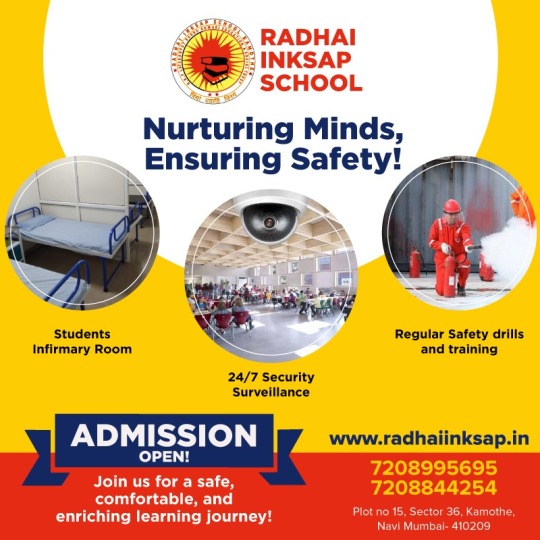
Benefits of Blended Learning
1. Personalized Learning: Blended learning allows for personalized learning experiences tailored to each student's unique needs, interests, and learning pace. Through online assessments, adaptive learning software, and individualized learning paths, students can receive targeted instruction and support that meets them where they are academically.
2. Flexibility and Accessibility: Blended learning provides flexibility in terms of time, pace, and location of learning. With access to online resources and materials, students can review lessons, complete assignments, and engage in collaborative activities at their own convenience, whether in the classroom, at home, or on the go.
3. Engagement and Interactivity: Blended learning leverages interactive multimedia resources, gamified activities, and social learning platforms to engage students and promote active participation in the learning process. By incorporating videos, simulations, virtual labs, and other interactive elements, teachers can make learning more dynamic, engaging, and memorable.
4. Data-Driven Instruction: Blended learning enables teachers to gather real-time data on student progress, performance, and engagement through online assessments, learning analytics, and digital portfolios. This data-driven approach allows teachers to identify areas of strength and weakness, provide timely feedback, and tailor instruction to meet the diverse needs of their students.
5. Preparation for the Future: In today's digital world, digital literacy and fluency are essential skills for success in higher education and the workforce. Blended learning equips students with the technological skills, self-directed learning habits, and collaborative abilities needed to thrive in the 21st century.
Implementing Blended Learning at Radhai Inksap School:
At Radhai Inksap School, we are committed to harnessing the power of blended learning to enhance the educational experience for our students. Through a combination of interactive whiteboards, educational software, online learning platforms, and digital resources, we create a blended learning environment that promotes student engagement, collaboration, and achievement.
Our teachers undergo regular training and professional development to effectively integrate technology into their instruction and design blended learning experiences that meet the diverse needs of our students. Whether through flipped classrooms, online discussions, virtual labs, or multimedia projects, we strive to create learning experiences that are interactive, immersive, and empowering.
Through blended learning, we aim to foster a culture of lifelong learning, curiosity, and innovation among our students, preparing them to navigate the complexities of the digital age with confidence and competence. By embracing the principles of blended learning, we empower our students to reach their full potential and succeed in an ever-changing world.
Visit Us: https://radhaiinksap.in/
1 note
·
View note